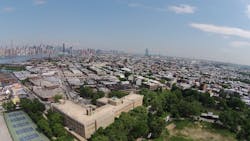NYC Building regulators, Pacific Northwest National Lab extend pilot study on Energy Code compliance
The New York City Department of Buildings and Pacific Northwest National Laboratory have extended their collaboration on a pilot study testing new approaches to energy codes.
The pilot study was launched last year. The goal is to improve big building efficiency and decarbonization goals. In New York City its stunning array of buildings produce nearly 70 percent of the city’s greenhouse gas emissions.
More impactful energy codes and efficiency practices could avoid more of those emissions, according to the partners. PNNL and the NYC Department of Buildings (NYCDB) are hoping the pilot study will produce learnings helpful to meet the city’s Local Law 32 on tighter building energy efficiency rules and also the overall goal to reach net-zero emissions by 2050.
The NYCDB oversees and regulates the city’s zoning and coding around its 1.1 million buildings.
Typically, a performance-based energy code, which is a subset of the overarching building codes, determines compliance based on projected energy performance of a building. Historically, the prescriptive approach, the longtime standard for building energy codes, considers compliance to be reached only if a checklist of requirements has been completed.
Related stories
Habitat Zero low-carbon Rental develoopment approved in Brownsville, Texas
Pacific Gas & Electric proposing $2B+ Energy Efficiency Initiative for customers
“This pilot is unique because for the very first time, we are testing the removal of the prescriptive approach that has always been used in energy codes,” said PNNL mechanical engineer and lead tool developer, Supriya Goel, on the PNNL website. “With the prescriptive approach, there is no extra credit for doing more, and if one thing is not done exactly, the whole building is considered non-code compliant.”
The impact of light and solar gain, for example, are not rewarded in the prescriptive code system, Goel added.
“For example, prescriptive codes typically limit the amount of light and solar gain allowed in by windows to reduce cooling energy. But well-planned designs that take advantage of passive heating, or those that automatically reduce the electric light required during the day, may benefit from increased solar gain. Performance-based codes can recognize these benefits, while prescriptive codes cannot.”
So PNNL developed a 100-percent performance-based code for the pilot study. One way to reach compliance is by whole building performance metrics on energy efficiency, while the other compliance tool evaluates energy at the building systems level, including heating ventilation and air conditioning (HVAC), lighting and “envelope system” components such as foundation, walls, roof, windows and doors, according to the report.
Lighting alone can make a significant difference. Nearly a decade ago, the NYC Fire Department completed LED retrofits and reduced energy consumption by an estimated 3 million kWh and 520 metric tons of CO2 annually.
“A performance-based code offers more flexibility in how we can evaluate a building’s energy efficiency,” said Goel. “A more efficient building results from making sure each building system is compliant on its own.”
PNNL built the COMcheck software toold to help document energy code compliance and assess building envelope systems. Lighting systems are being evaluated using PNNL’s Lighting System Performance Spreadsheet. And HVAC systems are being measured using the HVAC System Performance tool.
-- -- --
(Rod Walton, senior editor for EnergyTech, is a 14-year veteran of covering the energy industry both as a newspaper and trade journalist. He can be reached at [email protected]).
About the Author
Rod Walton, EnergyTech Managing Editor
Managing Editor
For EnergyTech editorial inquiries, please contact Managing Editor Rod Walton at [email protected].
Rod Walton has spent 17 years covering the energy industry as a newspaper and trade journalist. He formerly was energy writer and business editor at the Tulsa World. Later, he spent six years covering the electricity power sector for Pennwell and Clarion Events. He joined Endeavor and EnergyTech in November 2021.
Walton earned his Bachelors degree in journalism from the University of Oklahoma. His career stops include the Moore American, Bartlesville Examiner-Enterprise, Wagoner Tribune and Tulsa World.
EnergyTech is focused on the mission critical and large-scale energy users and their sustainability and resiliency goals. These include the commercial and industrial sectors, as well as the military, universities, data centers and microgrids. The C&I sectors together account for close to 30 percent of greenhouse gas emissions in the U.S.
He was named Managing Editor for Microgrid Knowledge and EnergyTech starting July 1, 2023
Many large-scale energy users such as Fortune 500 companies, and mission-critical users such as military bases, universities, healthcare facilities, public safety and data centers, shifting their energy priorities to reach net-zero carbon goals within the coming decades. These include plans for renewable energy power purchase agreements, but also on-site resiliency projects such as microgrids, combined heat and power, rooftop solar, energy storage, digitalization and building efficiency upgrades.

